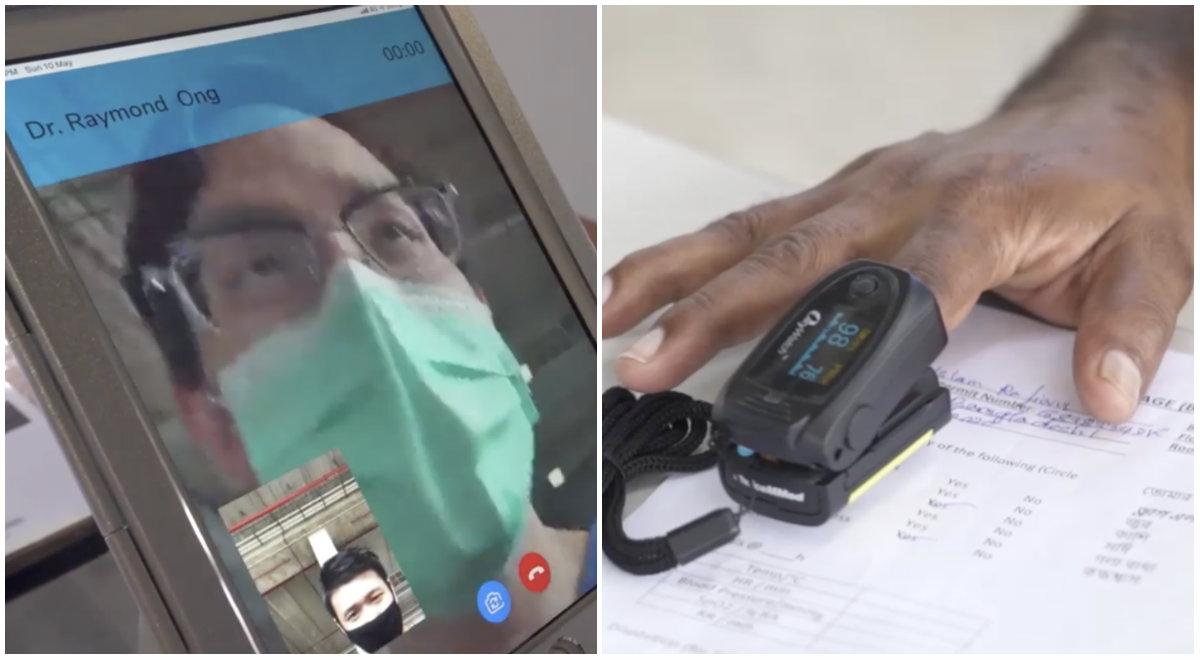Blood oxygen monitors and remote doctor consultations are being deployed to monitor the health of migrant workers who continue to be infected with COVID-19 at alarming rates.
A total of 8,000 devices, which are called pulse oximeters and measure heart rates and blood oxygen levels, have been distributed to those in the dormitories, where more than 20,000 people have been infected. Another 12,000 units will be distributed, according to Manpower Minister Josephine Teo.
“What the pulse oximeter enables us to do is to go beyond the usual symptoms such as fever,” she said today. “To also be able to tell a person’s heart rate as well as the level of oxygen in his blood.”
The vast majority of Singapore’s COVID-19 cases have now occurred in the worker dorms, where 20,961 residents have been infected. Islandwide, Singapore has logged 23,336 cases since the outbreak began in January, with 876 recorded just yesterday. The death toll stands at 20. Six others have died due to other causes, including heart-related conditions.
Other than the oximeters, infected migrant workers will now be able to consult doctors through their mobile phones or at “tele-kiosks” set up in the dormitories.
South Asians, which comprise a large portion of Singapore’s migrant worker population from Bangladesh, are known to have four times the risk of heart disease than other Asians, which puts them at higher risk of COVID-19 complications.
Roughly 400 video consultations between workers and doctors have occurred since the service started April 25, the Manpower Ministry said in a press release.
Eight kiosks have been installed at various dormitories to allow workers to consult with doctors by video link. Devices to evaluate vital signs such as blood pressure, oxygen saturation and temperature are also available.
“In summary, we are getting ready for the recovery phase through new approaches to monitor the health of our migrant workers and more robust health surveillance,” Teo said.
LEVERAGING TECHNOLOGY FOR PROMPT MEDICAL ATTENTION FOR MIGRANT WORKERS
LEVERAGING TECHNOLOGY FOR PROMPT MEDICAL ATTENTION FOR MIGRANT WORKERS
I visited a newly set-up medical post yesterday to take a look at some of the technologies we have deployed to enable more effective monitoring of the health of our migrant workers. This is the fifth facility of its kind and will serve about 10,000 workers living in factory converted dormitories (FCDs)and construction temporary quarters (CTQs) in the vicinity.
In the past few weeks, the Taskforce has been working round-the-clock to stabilise the situation at the dormitories and ensure that our migrant workers have good medical support. They are looking after about 400,000 workers, or twice the number of people in Ang Mo Kio GRC. It’s a big job.
Many people have put in tremendous efforts – our officers from the Singapore Armed Forces, Home Team and Singapore Ministry of Manpower, as well as the healthcare colleagues from the Regional Health System. In total, we have about 3,000 staff deployed now. Also, there are the dorm operators and employers, who have tried hard to meet new requirements to manage the outbreak. The workers too have been cooperative. They know they’re being cared for in every possible way.
NGOs and community partners have complemented these efforts. I want to say a big thank-you to all of the staff, our partners and the workers for chipping in.
With the progress we have made, we can now start to plan for the recovery phase. One key aspect in this phase is a system to monitor the health of these workers.
We have seen how even on cruise ships or aircraft carriers; the risk of transmission is higher. In these places, it’s two persons to a room, very high standards of hygiene generally. But it is still communal living, where you can’t avoid a virus like COVID-19. So anytime you have communal
living, you need a way to monitor health conditions, to detect infections.Another point is that we now know many of the workers who tested positive have mild or no symptoms. They may not think they are sick. So, the health monitoring must go beyond symptoms. This is why, in addition to thermometers, we have issued about 8,000 pulse oximeters to COVID-19 positive workers in dormitories. We will progressively distribute another 12,000. Depending on their condition, workers may be issued with a personal or shared device. The oximeter can give readings
on heart rate and oxygen levels in our blood and tell us if a worker is very unwell.But we actually don’t even want to wait till the worker is very unwell. We prefer to encourage them to seek help early. This is why we have made tele-consultations available to them so they can get help anytime, anywhere. This applies to all workers living in purpose-built dormitories (PBDs), FCDs and CTQs.
In addition, we have installed tele-kiosks at some PBDs and FCDs. These tele-kiosks allow the COVID-19 positive workers to talk to a doctor and get things like their blood pressure, temperature
and oxygen saturation checked out.With these measures in place, unwell workers can get help early. It must of course be complemented by a robust testing strategy. Minister Gan Kim Yong had explained that one type of testing is for health surveillance, which will of course include our migrant workers.
In summary, we are getting ready for the recovery phase through new approaches to monitor the health of our migrant workers and more robust health surveillance. – Jo TeoPosted by Josephine Teo on Sunday, 10 May 2020
Other stories you should check out:
Filthy, cramped dorms come to light as virus afflicts Singapore’s migrant workers
Medical staff vow to leave no one behind in rousing speech to migrant workers (Video)
MP put on blast for saying ‘it takes a virus’ to clear field of foreign workers
MOH says 35 people misdiagnosed with COVID-19





Reader Interactions